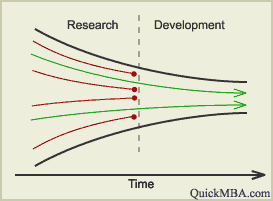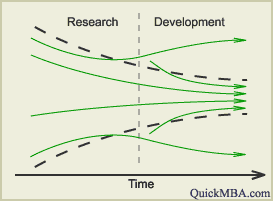Innovation and entrepreneurship are at the heart of "creative destruction". In his book, Open Innovation, Henry Chesbrough describes a new paradigm of open innovation that is in contrast to the traditional closed model. To understand open innovation, it is worthwhile to review the older model of closed innovation.
The Closed Innovation Model
Under the concept of innovation that prevailed during most of the 20th century, companies attained competitive advantage by funding large research laboratories that developed technologies that formed the basis of new products that commanded high profit margins that then could be plowed back into research. This vertical integration of the research function meant that firms that could not afford such research were at a disadvantage. The vertically integrated concept of the research and development pipeline is depicted in the following diagram:

In the above diagram, the red lines represent completed research projects, some of which may have resulted in patents, but that never made it to development. This often is the situation if the innovation is not useful to the company's core business. Such completed research projects often are shelved until a market opportunity arises to use them, if such an opportunity arises at all.
Chesbrough observed that this closed model began to change in the 1990's, when firms such as Cisco Systems competed very effectively with research-endowed companies such as Lucent Technologies (which inherited most of Bell Labs).
Erosion of the Closed Innovation Paradigm
There now are many famous cases in which companies have developed disruptive technologies but have nonetheless failed to capitalize on them. One reason for failure is that managers often wrongly assume that just because customers are fascinated by an innovation, there also exists a corresponding business model. Henry Chesbrough used the Xerox Palo Alto Research Center (PARC) as an example. The research from PARC spawned many successful products, but the shareholders of Xerox did not benefit as much as others did. Employees who worked on promising technologies departed to form start-up companies, many of which, such as 3Com and Adobe, acheived much success. In fact, the market capitalization of Xerox's spin-offs exceeded that of Xerox itself.
The Xerox PARC example raises questions about the viability of the closed innovation model going forward in the 21st century. According to Chesbrough, the closed innovation paradigm has eroded due to the following factors:
- Increased mobility of skilled workers
- Expansion of venture capital
- External options for unused technologies
- Increased availability of highly-capable outsourcing partners
Open Innovation Paradigm
Rather than being held closely within the firm, under the concept of open innovation research results are able to traverse the firm's boundaries. Other companies that are able to utilize a technology can license it, creating a win-win situation. Similarly, the firm may be able to license the technologies created by other firms. This concept of open innovation is illustrated in the following diagram:

This diagram uses dashed lines to illustrate that the boundaries of the firm are porous. The lines exiting the firm represent technologies that are licensed to other firms and that otherwise would have gone unutilized (they were the red lines in the closed innovation diagram). The lines entering the firm represent outside technologies that are licensed to the firm. These are technologies that did not originate in the firm's own research laboratories but nonetheless are useful in the firm's core business.
Internal Ventures
Established companies often view entrepreneurs and the venture capitalists who fund them as a threat. Chesbrough argues that they should be viewed as laboratories that test market real products to real customers. In a dynamic entrepreneurial economy, such information can be more useful than more hypothetical marketing research. Some large firms have taken the open innovation model further by forming alliances with start-ups or even acquiring them. The more progressive firms have formed their own internal venture groups to power their own innovation process.
Operating an internal new ventures group provides the firm with the following benefits:
- It allows the monetization of technologies that otherwise would go unused in the firm's own business.
- The venture process brings the technologies to market quicker.
- It provides valuable feedback by applying the technology to different uses in different markets.
When there is innovation in the business model itself, a ventures group is a tool for rapidly protoyping new business models.
Business Model for Innovation
Technology only has value when it is commercialized by means of a business model. The dot-com boom and bust illustrates this concept well, as there was much innovation but relatively few business models that could capture the potential value of the new technologies. According to Chesbrough, a firm can capture value from an innovation in the following three ways:
- Using the technology in its existing business
- Licensing the technology to other firms
- Launching a new venture that uses the technology
Given the complexities of products, markets, and the environment in which the firm operates, very few individuals, if any, fully understand the organization's tasks in their entirety. The business model serves to connect the entrepreneurial inputs to the economic outputs.
Intellectual Property and Open Innovation
In the historical model of vertically integrated research, new technologies were used in the firm's core business. Other potential uses of the technology did not unfold.
Under the model of open innovation, the same intellectual property can be applied to different markets. The firm creating the IP may license it to one firm for use in one market, and other firms for use in their respected markets.
Chesbrough used Millennium Pharmaceuticals as an example of a young company that built its business model around the concept of open innovation for the licensing of intellectual property. Millennium supplies information and analysis of biological compounds useful to large pharmaceutical firms in drug development.
Previous business models for such firms involved contracting the services. Those firms are known as contract research organizations, and they essentially performed the work on a contract basis with the pharmaceutical firms owning the resulting intellectual property. Two disadvantages of this model are:
- the potential value of the intellectual property would not be unlocked since it would be confined to the market of the pharmaceutical firm paying for the services, and
- the growth of such a pay-per-service firm is somewhat limited since there are few economies of scale.
Millennium Pharmaceuticals developed a business model whereby Millennium retained ownership of the IP that it developed and licensed the IP to the larger pharmaceuticals. Exclusivity was given for specific markets, but each biological target that resulted could be licensed to different firms for use in different markets, with exclusivity given for each market. The full potential value of the IP could be unleashed since it would not be hoarded for use in the core business of one firm. This model created a win-win situation whereby the potential value of the IP was distributed to both Millennium and the pharmaceuticals as follows:
- Millennium retained ownership of the IP and therefore could generate additional revenue by licensing it to other firms for use in other markets.
- The large pharmaceutical firms gained the intellectual property they needed at a cost lower than they would have incurred had they acquired complete ownership of it.
The example of Millennium Pharmaceuticals illustrates both the benefits of open innovation and the importance of the business model in unleashing value.
Recommended Reading
Henry Chesbrough, Open Innovation : The New Imperative for Creating and Profiting from Technology
The book on which this article is based, Open Innovation explains why closed innovation no longer works in entrepreneurial, high-technology industry and how firms can make the transition to an open innovation model.
Table of Contents
The book on which this article is based, Open Innovation explains why closed innovation no longer works in entrepreneurial, high-technology industry and how firms can make the transition to an open innovation model.
Table of Contents
| Foreword Acknowledgments Introduction | |
| 1. | Xerox PARC The Achievements and Limits of Closed Innovation |
| 2. | The Closed Innovation Paradigm |
| 3. | The Open Innovation Paradigm |
| 4. | The Business Model Connecting Internal and External Innovation |
| 5. | From Closed to Open Innovation The Transformation of the IBM Corporation |
| 6. | Open Innovation @ Intel |
| 7. | Creating New Ventures out of Internal Technologies Lucent's New Ventures Group |
| 8. | Business Models and Managing Intellectual Property |
| 9. | Making the Transition Open Innovation Strategies and Tactics |
| Notes Index About the Author |






No comments:
Post a Comment